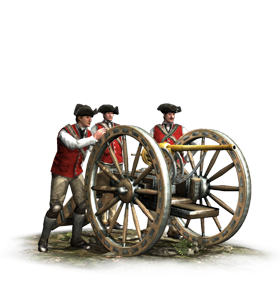Difference between revisions of "Puckle Guns (ETW Unit)"
Tango12345 (talk | contribs) m (updating category) |
(→Overview) |
||
| Line 1: | Line 1: | ||
{{Unit|image=[[File:puckle.jpg]]|Class=Artillery|Men=24|Guns=4|Recruitable From=Ordinance Board|Region=Worldwide|Recruitment Cost=1140|Upkeep Cost=280|Technology Needed=None}} | {{Unit|image=[[File:puckle.jpg]]|Class=Artillery|Men=24|Guns=4|Recruitable From=Ordinance Board|Region=Worldwide|Recruitment Cost=1140|Upkeep Cost=280|Technology Needed=None}} | ||
| − | == | + | ==Game Description== |
It achieves its rapid-fire capability by using pre-loaded breech chambers that are rotated into line with the barrel, fired and then a new chamber is positioned for the next shot. All this is achieved mechanically, by the operator revolving a handle at the back of the piece. As long as loaded magazines are available for the piece, a puckle gun can be kept in rapid fire action! | It achieves its rapid-fire capability by using pre-loaded breech chambers that are rotated into line with the barrel, fired and then a new chamber is positioned for the next shot. All this is achieved mechanically, by the operator revolving a handle at the back of the piece. As long as loaded magazines are available for the piece, a puckle gun can be kept in rapid fire action! | ||
Revision as of 19:37, 30 August 2011
Game Description
It achieves its rapid-fire capability by using pre-loaded breech chambers that are rotated into line with the barrel, fired and then a new chamber is positioned for the next shot. All this is achieved mechanically, by the operator revolving a handle at the back of the piece. As long as loaded magazines are available for the piece, a puckle gun can be kept in rapid fire action!
Historically, James Puckle’s “defence gun” was not a huge success, partly because the engineering of 1718 simply wasn't up to the task of producing components with fine tolerances. His gun had promise, though, as it could fire shots around three times faster than a well-trained fusilier. One odd feature of the design was the two versions offered to potential customers: a round barrel fired conventional bullets for shooting at Christian (but not Protestant) enemies, while a second barrel was offered that fired square bullets (that allegedly did more damage) for use against Turks and similar unwelcome infidels. The British Royal Navy never bought any, and other users were equally reluctant to part with their money. Puckle’s career as a gunsmith ended in failure for him and his investors.
Factions
Tactics
The Puckle Gun is most effective at close range, since at longer ranges many shots don't hit the target. It is useful for repelling a cavary charge, if you get the timing right.
